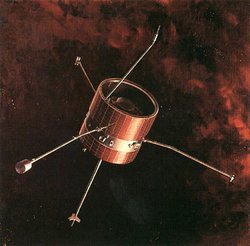Pioneer 6, 7, 8, and 9
|
Artist's conception of the Pioneer 6–9 spacecraft.
|
|
| Mission type | Interplanetary space |
|---|---|
| Operator | NASA |
| COSPAR ID | 1965-105A (Pioneer 6) 1966-075A (Pioneer 7) 1967-123A (Pioneer 8) 1968-100A (Pioneer 9) |
| Spacecraft properties | |
| Manufacturer | TRW |
| Launch mass | 146, 138, 146, 147 kg |
| Power | 79 W |
| Start of mission | |
| Launch date |
Pioneer 6: December 16, 1965, 07:31:00 UTC Pioneer 7: August 17, 1966, 15:20:00 UTC Pioneer 8: December 13, 1967, 14:08:00 UTC Pioneer 9: November 08, 1968, 09:46:00 UTC |
| Rocket | Delta-E |
| Launch site | Cape Canaveral LC-17A |
| Orbital parameters | |
| Reference system | Heliocentric |
| Perihelion | between 0.7 to 1 AU |
| Apohelion | between 0.9 to 1.2 AU |
Pioneer 6, 7, 8, and 9 were space probes in the Pioneer program. Together, they formed a series of solar-orbiting, spin-stabilized, solar-cell and battery-powered satellites designed to obtain measurements on a continuing basis of interplanetary phenomena from widely separated points in space. They were also known as Pioneer A, B, C, and D. The fifth (Pioneer E) was lost in a launch accident.
Pioneers 6, 7, 8, and 9 were created to make the first detailed, comprehensive measurements of the solar wind, solar magnetic field and cosmic rays. They were designed to measure large scale magnetic phenomena and particles and fields in interplanetary space. Data from the vehicles has been used to better understand stellar processes and the structure and flow of the solar wind. The vehicles also acted as the world's first space-based solar weather network, providing practical data on which impact communications and power on Earth.
The experiments studied the positive ions (cations) and electrons in the solar wind, the interplanetary electron density (radio propagation experiment), solar and galactic cosmic rays, and the Interplanetary Magnetic Field.
Each craft was identical, with an on-orbit dry mass of 146 kg. They were spin-stabilized 0.94 m diameter × 0.81 m tall cylinders with a 1.8 m long magnetometer boom and solar panels mounted around the body.
The main antenna was a high-gain directional antenna. The spacecraft were spin-stabilized at about 1 Hz, and the spin axis was perpendicular to the ecliptic plane and pointed toward the south ecliptic pole.
...
Wikipedia

